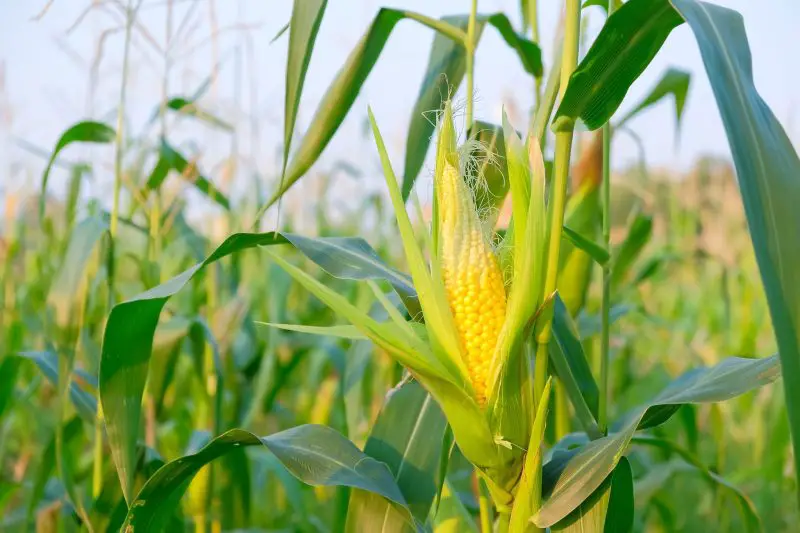Few crops are as familiar or globally cultivated as corn, a staple in both home gardens and industrial agriculture. From backyard gardens to vast commercial fields, it plays a key role in diets, economies, and cultures. But while corn is common, understanding its full growing timeline is essential for a successful harvest. For both new and seasoned growers, a frequent question arises: How long does corn take to grow and when should you harvest it for peak flavor and yield?
The growth period of corn depends on several variables, including variety, weather, soil quality, and planting time. Sweet corn, field corn, and popcorn all develop at slightly different rates, but the fundamentals of corn growth remain largely the same. Knowing the average duration from planting to harvest—and the key signs of maturity—can make the difference between an underwhelming yield and a bountiful harvest.
Table of Contents
Understanding Corn Growth Stages

Corn development follows a predictable series of stages, beginning with germination and culminating in harvest. The first phase starts when the seeds are sown in warm soil and begin to sprout. Within a few days, young shoots push above the ground, establishing the plant’s early structure. This is followed by a rapid vegetative growth phase, during which corn plants can grow several inches per day under ideal conditions.
As the plants mature, they begin producing tassels at the top and silks near the ears. This signals the beginning of the reproductive stage, when pollination takes place. The silks capture pollen from the tassels, leading to kernel development. Over the next few weeks, the kernels mature and fill out, gradually changing color and texture. Once the kernels are fully developed and the husks dry out, the corn is ready for harvest.
Average Growing Time for Corn Varieties
The time it takes for corn to reach maturity varies slightly between types. Sweet corn typically requires between 60 and 100 days from planting to harvest. Early-maturing varieties may be ready in just two months, while longer-season types can take over three months. Field corn and popcorn usually have longer growing periods, sometimes extending to 120 or even 130 days.
These timelines are influenced by growing conditions. In warm climates with consistent moisture and full sun, corn often matures faster. In cooler or more variable environments, the growth period may extend by several weeks. While seed packets and catalog descriptions provide estimated maturity dates, real-world results often differ slightly, making local observation essential.
Climate and Temperature Influence on Growth Duration
Corn is a warm-season crop that thrives in temperatures ranging from 60°F to 95°F. Germination occurs best when soil temperatures reach at least 50°F, with optimal results closer to 60°F or higher. When planted in soil that’s too cool, corn seeds may struggle to sprout or suffer from early root diseases, delaying development.
During the growing season, warm daytime temperatures promote rapid vegetative growth, while nighttime warmth helps maintain consistent progress. However, excessive heat—especially during pollination—can harm kernel formation. Conversely, unseasonal cold spells can stunt growth and extend the time to maturity. Gardeners in cooler regions often wait until late spring to plant, while those in southern areas can plant earlier and enjoy an earlier harvest.
Soil Conditions and Their Effect on Growth Speed
Healthy soil plays a major role in how quickly corn grows. Nutrient-rich, well-drained soil provides the foundation for strong root systems and steady development. Corn is a heavy feeder, particularly reliant on nitrogen for building lush foliage and sturdy stalks. Deficiencies in key nutrients such as phosphorus or potassium can slow down growth and reduce yields.
Compacted or poorly draining soils hinder root expansion, while overly sandy soils may dry out too quickly. For optimal results, soil should be prepared with compost or well-rotted manure before planting. Adding balanced fertilizers during the early growth stages can further support vigorous development and help maintain the expected timeline from planting to harvest.
The Role of Water and Sunlight in Corn Maturity
Corn requires consistent moisture throughout its growing season, especially during tasseling and ear development. Water stress at these stages can lead to incomplete kernel formation and delayed maturation. On average, corn needs about one to one and a half inches of water per week. This can come from rainfall or irrigation, but it must be steady and timely.
Sunlight is another crucial factor. Corn plants need full sun—at least six to eight hours daily—to photosynthesize effectively and grow tall and strong. In shaded locations, corn often grows slowly and may produce weak or malformed ears. Proper spacing is also important to ensure each plant receives adequate light. With optimal sun exposure and regular watering, corn usually matures within the timeframe advertised by the seed supplier.
Timing Your Planting for the Best Harvest Window
The date you plant your corn has a direct impact on how long it will take to grow. Early spring planting, once the soil warms, typically results in a midsummer harvest. Later plantings may push your harvest into late summer or early fall. By calculating backward from your desired harvest window, you can plan your sowing date accordingly.
For example, if your goal is to harvest corn in late July, you should plant a 75-day variety in mid-May. In cooler zones, planting may not be feasible until the end of May or early June, which means harvesting will occur in August or early September. Understanding your region’s frost dates is also essential, as planting too late may risk crop damage before full maturity is reached.
Observing Physical Signs of Corn Maturity
While counting days is a helpful guideline, observing physical signs is the most reliable way to determine when corn is ready to harvest. Sweet corn, for example, is ready when the silks turn brown and dry out, and the kernels are plump and milky when punctured. At this stage, the ears feel full and firm when squeezed, and the husk remains green.
Field corn and popcorn are typically harvested when the plant has dried out entirely. The ears rattle when shaken, and the kernels are hard and glossy. These types are often left on the stalks until the moisture content drops significantly, allowing for safe long-term storage. In all cases, watching the color, texture, and feel of the ears will guide you toward the ideal harvest moment.
Early, Mid, and Late-Season Varieties
Corn is available in a wide range of cultivars, classified by the length of their growing season. Early-season varieties often mature in 60 to 70 days and are popular among northern gardeners or those seeking a quicker crop. Mid-season types require around 80 days and provide a balance between flavor and productivity. Late-season cultivars can take 90 to 110 days but often reward growers with large, full ears and rich flavor.
Choosing the right variety for your region and needs helps you control your harvest schedule. If you wish to stagger harvests throughout the summer, you can plant multiple varieties with different maturation rates. This method ensures a continuous supply of fresh corn over several weeks, with each type reaching maturity at a different time.
The Best Time of Day to Harvest Corn
When your corn is ready, the time of day you pick it can affect its flavor and texture. Corn harvested in the early morning retains higher sugar content and moisture, resulting in sweeter, crisper kernels. As the day progresses and temperatures rise, the sugars in corn begin to convert to starch, slightly dulling the sweetness.
If possible, harvest sweet corn in the morning and refrigerate it promptly to preserve its flavor. For field corn and popcorn, the timing within the day is less important since these types are typically dried and stored rather than eaten fresh. However, waiting for several dry days before harvesting helps reduce the moisture content and prevents mold or spoilage during storage.
Post-Harvest Handling for Peak Freshness
Once harvested, sweet corn begins to lose its sugar rapidly, so it’s best consumed as soon as possible. If immediate use isn’t possible, storing it in a refrigerator helps slow down sugar loss. Wrapping the ears in a damp cloth or storing them in airtight containers maintains moisture and texture.
For longer-term storage, sweet corn can be blanched and frozen. Field corn, used for animal feed or processing, is often shelled and kept in dry bins. Popcorn must be dried to a specific moisture level—usually around 13%—before it will pop properly. Each type of corn has specific storage needs, but all benefit from careful handling right after harvest.
Common Problems That Delay Corn Maturity
Various factors can slow corn’s development, pushing harvest dates later than expected. Pests such as corn earworms or cutworms can damage developing ears, reducing yield and affecting timing. Diseases like smut or blight can also weaken plants and delay maturity.
Environmental stress, including drought, nutrient imbalance, or poor pollination, contributes to uneven or stunted ear growth. If the ears don’t fill properly, harvest must be delayed while remaining kernels mature. Monitoring plant health throughout the season allows you to adjust your expectations and take corrective action if needed.
FAQs About Growing and Harvesting Corn
How long does corn take to grow from seed to harvest?
Corn typically takes between 60 to 100 days to grow, depending on the variety and growing conditions. Early-maturing sweet corn can be ready in as little as 60 days, while field corn or popcorn may need up to 120 days.
What month should I plant corn?
Corn should be planted in spring once soil temperatures reach at least 50°F (10°C). In most regions, this means planting between April and June. Planting time determines your harvest window later in the season.
When is the best time to harvest sweet corn?
Sweet corn is ready to harvest when the silks have turned brown and dry, and the kernels are plump and release a milky liquid when pressed. This usually occurs about 20 days after the silks first appear.
Can I plant multiple batches of corn for continuous harvest?
Yes, succession planting every two to three weeks during spring and early summer can give you a continuous supply of corn over several months, with staggered harvest dates from mid-summer to early fall.
What are signs that corn is ready to be harvested?
For sweet corn, look for brown silks, firm husks, and milky kernels. For field corn or popcorn, the ears and stalks dry out completely, and the kernels become hard and glossy.
How does temperature affect how fast corn grows?
Corn grows fastest in warm temperatures between 70°F and 85°F. Cold or extremely hot weather can delay growth or reduce kernel development, affecting how long the crop takes to mature.
How much water does corn need to grow well?
Corn typically needs 1 to 1.5 inches of water per week. Adequate watering is especially important during pollination and ear development stages to ensure full, healthy kernels.
Can I harvest corn in the morning?
Yes, harvesting corn in the early morning is recommended, especially for sweet corn. The kernels retain more moisture and sugar before the heat of the day, resulting in better flavor.
What happens if I harvest corn too late?
Harvesting too late may lead to tough, starchy kernels in sweet corn. For field corn or popcorn, delayed harvest may risk kernel loss or mold if weather conditions turn wet.
Can I grow corn in containers?
While possible, growing corn in containers is challenging due to its large root system and space needs. If attempted, use large containers and ensure proper pollination among the plants.
Final Thoughts on Corn Growing Time and Harvest Planning
Growing corn successfully means balancing patience with precision. While most varieties fall within a 60 to 100-day range from planting to harvest, the actual timeline can vary depending on conditions and care. Understanding your local climate, preparing your soil, and selecting the right variety are all key steps in managing this timeline effectively.
Careful observation during the growing season helps refine your expectations. Rather than relying solely on the calendar, pay close attention to the physical signs of maturity. When your corn has full ears, browned silks, and milky kernels—or dry, hard ones in the case of field corn—you’ll know the harvest is near. With the right timing and attention, your corn crop can be flavorful, abundant, and worth every day of the wait.






